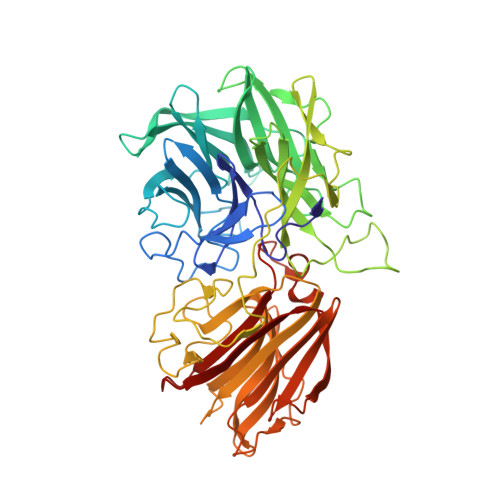The Structure of an Inverting GH43 beta-Xylosidase from Geobacillus stearothermophilus with its Substrate Reveals the Role of the Three Catalytic Residues.
Brux, C., Ben-David, A., Shallom-Shezifi, D., Leon, M., Niefind, K., Shoham, G., Shoham, Y., Schomburg, D.(2006) J Mol Biol 359: 97-109
- PubMed: 16631196
- DOI: https://doi.org/10.1016/j.jmb.2006.03.005
- Primary Citation of Related Structures:
2EXH, 2EXI, 2EXJ, 2EXK - PubMed Abstract:
beta-D-Xylosidases are glycoside hydrolases that catalyze the release of xylose units from short xylooligosaccharides and are engaged in the final breakdown of plant cell-wall hemicellulose. Here we describe the enzyme-substrate crystal structure of an inverting family 43 beta-xylosidase, from Geobacillus stearothermophilus T-6 (XynB3). Each XynB3 monomeric subunit is organized in two domains: an N-terminal five-bladed beta-propeller catalytic domain, and a beta-sandwich domain. The active site possesses a pocket topology, which is mainly constructed from the beta-propeller domain residues, and is closed on one side by a loop that originates from the beta-sandwich domain. This loop restricts the length of xylose units that can enter the active site, consistent with the exo mode of action of the enzyme. Structures of the enzyme-substrate (xylobiose) complex provide insights into the role of the three catalytic residues. The xylose moiety at the -1 subsite is held by a large number of hydrogen bonds, whereas only one hydroxyl of the xylose unit at the +1 subsite can create hydrogen bonds with the enzyme. The general base, Asp15, is located on the alpha-side of the -1 xylose sugar ring, 5.2 Angstroms from the anomeric carbon. This location enables it to activate a water molecule for a single-displacement attack on the anomeric carbon, resulting in inversion of the anomeric configuration. Glu187, the general acid, is 2.4 Angstroms from the glycosidic oxygen atom and can protonate the leaving aglycon. The third catalytic carboxylic acid, Asp128, is 4 Angstroms from the general acid; modulating its pK(a) and keeping it in the correct orientation relative to the substrate. In addition, Asp128 plays an important role in substrate binding via the 2-O of the glycon, which is important for the transition-state stabilization. Taken together, these key roles explain why Asp128 is an invariant among all five-bladed beta-propeller glycoside hydrolases.
Organizational Affiliation:
Institute for Biochemistry, University of Cologne, Germany.


















